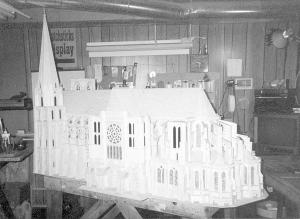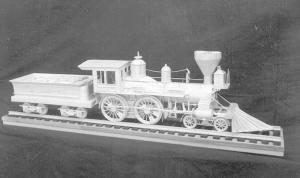2003 - Volume #27, Issue #2, Page #24
[ Sample Stories From This Issue | List of All Stories In This Issue | Print this story
| Read this issue]
"Believe It Or Not" Matchstick Models
 |
 |
"While in high school, I'd learned how to make cabinets but I didn't have the money to buy my own tools," he says.
But he still wanted to do something with wood. So Acton began building with matchsticks. His first project was a small country church that he gave to a neighbor who was a Methodist minister. His next project was a little more involved. "It was a hip-roofed barn that I made for my father for Christmas," he says.
Now, 25 years and 50 models later, Acton is an authority on matchstick construction. He's sold several of his models to Ripley's "Believe it or Not" museums in several U.S. cities and around the world.
"It's become a somewhat lucrative hobby," he says. "I've been able to put together the woodworking shop I always wanted, but it's all devoted to matchsticks."
Acton's latest projects are scale replicas of the U.S. Capitol building and the Notre Dame Cathedral of Chartres, France. The Capitol building, complete with columns and porticos, contains nearly half a million matchsticks. In terms of size and number of matchsticks, it's his biggest undertaking to date. The Chartres Cathedral has about 300,000 matchsticks in it. He figures he's spent 2,000 hours working on the Capitol building.
While there are probably thousands of people who have built with matchsticks, it's doubtful there are any who have become as adept at it as Acton. He's developed techniques that allow him to form columns, curves, and flat sheets that can be cut and finished. He's used the skills he's gained to duplicate buildings, ships, birds, Civil War era cannon, airplanes, trains, covered wagons, stagecoaches, eagles with their wings spread, and even a model of the U.S. space shuttle that's 8 ft. tall. His model of the battleship USS Iowa is more than13 ft. long and has anti-aircraft guns turned on a lathe from a single matchstick.
When he started building with matchsticks, one of Acton's biggest problems was getting rid of the match heads. "I spent hours with a utility knife cutting them off one at a time. I probably cut the heads off of a million matches," he says.
"My wife had been suggesting for years that I contact one of the match makers about buying matchsticks without heads on them. I was afraid they'd think I was some kind of nutcase, but finally I wrote to the Ohio Bluetip Match Company. They wrote back asking how many I wanted and were happy to ship them to me," he says.
Ohio Bluetip was later purchased by Diamond Brands, Cloquet, Minnesota, which now makes nearly all of the wooden matches sold in North America. Acton can now buy as many matchsticks without heads as he wants for about $50 per 33,000 sticks. And Diamond reports that thanks to him and others like him, they're selling more matchsticks without heads than they are matches. The company also sells craft quality clothespins and popsicle sticks.
While Acton has sold several of his creations, he says he no longer makes them for sale. "I've also made some on commission over the years, but I've found that the motivation isn't the same. I much prefer making something I want to make," he says.
Most of Acton's Matchstick projects will be on display at his home town's new Community Center when it's completed. While he expects the building to open sometime this spring, Acton notes it's being constructed and finished with mostly volunteer labor, so it's not possible to pinpoint an exact date at this time. He says if you're going to be in the area and want to see the display, you can call him or send an E-mail to find if it's open.
Contact: FARM SHOW Followup, Pat Acton, Box 154, Gladbrook, Iowa 50635 (ph 641 473-2230; E-mail: p.acton@mchsi.com).

Click here to download page story appeared in.

Click here to read entire issue
To read the rest of this story, download this issue below or click here to register with your account number.




